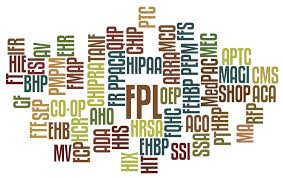 Summary: What do the ACA, ACO,
Summary: What do the ACA, ACO,  Summary: What do the ACA, ACO, MCO, FFS, DHS, and QHP all have in common? They are healthcare acronyms and most are related to the Affordable Care Act.
Summary: What do the ACA, ACO, MCO, FFS, DHS, and QHP all have in common? They are healthcare acronyms and most are related to the Affordable Care Act.
The healthcare industry is not unlike any other industry or almost any aspect of our lives these days, especially with the advent of texting. There is always a shorter way to say something i.e. “BFF” – best friends forever or one of my favorites “*$” – Starbucks.
ACA Acronyms – Oversight
The ACA, which is part of the “PPACA” – Patient Protection and Affordable Care Act of 2010, is regulated by “HHS” – the division of Health and Human Services, the “DOL” – Department of Labor and the “IRS” – Internal Revenue Service. HHS designates many responsibilities to “CMS” – the Centers for Medicare and Medicaid Services.
ACA Acronyms – Reimbursement
So, let’s think about some of the acronyms associated with “$” – reimbursement. Healthcare as we know it is transitioning from a “FFS”, fee-for-service delivery model to one based on value, “VBP” – value-based purchasing. This transition creates a shift of risk from payers to providers and a change in mentality from being reimbursed on a quantity and volume basis to a quality and value basis. The extremely difficult part is the transition. FFS is still in still very much alive and well and the primary way providers are reimbursed. So, it becomes a balancing act of still concentrating on volume while changing thinking, culture, processes and infrastructure to a system based on value. Along the path of transition, new delivery models are emerging such as “ACOs” – Accountable Care Organizations and bundled payments. These models are based upon coordination of care to achieve both cost savings and quality outcomes.
ACA Acronyms – Insurance
The number of insurance acronyms in use is mind-boggling, but let’s touch on a few. An “HIX” refers to a healthcare exchange, a marketplace for individuals to purchase insurance. In order to be considered a plan on the HIX, a plan must be deemed a “QHP” or qualified health plan. QHPs must provide “EHBs” or essential health benefits. There are currently 10 such EHBs. Additionally, “SHOPs” are emerging which are small business health options programs. According to healthcare.gov, SHOP is a “marketplace designed to help businesses provide health insurance coverage to employees”. Additionally, one of the programs, which comes under the jurisdiction of CMS, is “CHIP” – the Children’s Health Insurance Program. According to Medicaid.org, CHIP “provides health coverage to nearly eight million children in families with incomes too high to qualify for Medicaid, but can’t afford private coverage. Signed into law in 1997, CHIP provides federal matching funds to states to provide this coverage.”
ACA Acronyms – Technology
The world of technology as it relates to healthcare is changing faster than we can keep up. Way back in the day, “HIPAA” – Health Insurance Portability and Accountability Act of 1996 came into play to help protect “PHI” or personal health information. The security and privacy of individual’s medical information is sacred and is taken very seriously as seen in this Act issued by HHS. Today, efforts are being made to share PHI by utilizing “EMR” electronic medical records and “EHR” electronic health records technology. Safety and security of this information is in the forefront of any EHR/EMR system. EHR systems have expanded and become part of “HIEs” or health information exchanges. According to healthit.gov, “electronic health information exchange (HIE) allows doctors, nurses, pharmacists, other health care providers and patients to appropriately access and securely share a patient’s vital medical information electronically—improving the speed, quality, safety and cost of patient care”.
ACA Acronyms – Conditions
A few of the acronyms used for conditions as they relate to the ACA are “HAC”, “AMI”,”HF”, and “PN”. HAC stands for hospital acquired conditions and includes issues such as a foreign object retained after surgery. Not to be outdone, the Readmission Reductions Program currently will penalize hospitals which have admission rates higher than average for AMI – Acute Myocardial Infarction, HF – heart failure, and PN – Pneumonia. 3 additional conditions are scheduled to be added in 2015, which will also be included in the Readmissions program: “COPD” – chronic obstructive pulmonary disease ; “THA” – patients admitted for elective total hip arthroplasty , and “TKA” – total knee arthroplasty .







